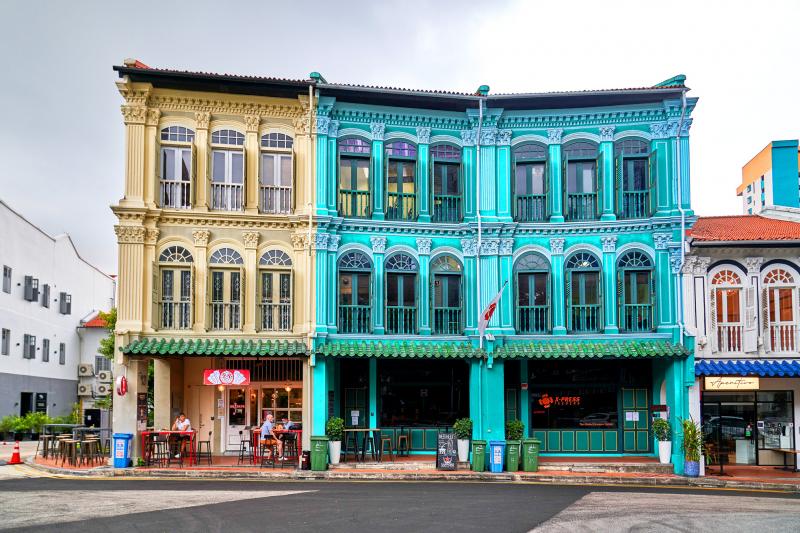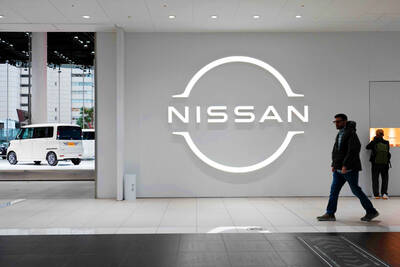With a tantalizing array of satay chicken, wok-fried mud crab and chilled tiger prawns, the dinner buffet at Singapore’s Grand Hyatt hotel typically sets diners back about US$70. Those on a tighter budget and with an eye on sustainability can fill a box for one-tenth of that price.
Across Asia, tech start-ups are taking food otherwise destined for landfill and providing discounted meals through mobile phone apps.
About one-third of food is lost or wasted every year globally, and the mountains of waste are estimated to cause 8 to 10 percent of greenhouse gas emissions such as methane, the UN says.

Photo: Bloomberg
The Asia-Pacific region is among the worst in the world for food waste, accounting for more than half of food squandered globally.
“A common mantra that I have is that being sustainable should be attainable,” said Preston Wong, chief executive officer and cofounder of Treatsure, which collaborates with chains including the Hyatt, Accor Group and the Singapore Marriott Tang Plaza Hotel to allow app users to pick out and collect a “buffet-in-a-box” of food that would otherwise be thrown out.
“I think technology can bridge that gap,” he said.
With more than 30,000 users, Treatsure has saved an estimated 30 tonnes of food from going to waste since it launched in 2017, with users typically having to wait until the end of service before they can collect their food, Wong said.
Still, that is a far cry from the 817,000 tonnes of food waste in Singapore last year, a 23 percent increase from the year prior.
Authorities say the city state’s only landfill, Semakau, is expected to meet Singapore’s solid waste disposal needs up to 2035 and beyond.
Hong Kong faces similar problems.
It has already filled up 13 landfills, and about 3,300 tonnes of food waste per day were dumped in its remaining sites in 2020, the Hong Kong Environmental Protection Department says.
“The space is very limited,” said Anne-Claire Beraud, Hong Kong country manager of Phenix by OnTheList, an app launched in the territory last year. “Everything is very dense so there isn’t a lot of space to treat all this waste.”
The app allows users to pick up a “Mystery Basket” of food at stores including Pret A Manger and local cake shop The Cakery for a minimum 50 percent discount.
So far it has sold 25,000 baskets, with each equating to about 1kg of food saved from going to waste and 4.5kg of carbon dioxide emissions avoided, the company says.
Phenix’s original platform was launched in France in 2014 and expanded to four other European countries where it has saved 150 million meals. It collaborated with OnTheList, a flash-sale company, to bring the app to Asia.
The concept of food sustainability is still in its infancy in Asia, compared with North America and Europe where authorities are cracking down. France has already banned supermarkets from throwing away unsold food, and Spain recently drafted legislation to tackle waste by fining companies. US states including California and New Jersey have laws to reduce the amount of food going to landfills.
That has boosted the popularity of apps such as Too Good To Go, which was launched in Denmark in 2016 and now operates in 17 countries including the US, Canada and the UK. It has has provided more than 152 million meals through its so-called Magic Bags, which are sold at a discount by shops and restaurants at the end of the day with items that would otherwise have been thrown out.
In a region as culturally diverse as Asia, smaller local start-ups are getting a foothold catering to their home market.
Companies “have to match that region’s culture and habits,” said Taichi Isaku, cofounder and chief product officer of CoCooking, which created the Tabete food-rescue app in Japan. “It’s an area that has to be nurtured in order to successfully introduce new technologies.”
Tabete, released in 2018 in Japan, is a free app with a similar business model to Too Good To Go. It has rescued 384,000 meals, accumulated 525,000 users, and partnered with 2,140 shops.
Tess Kermode, director of international expansion at UK-based Olio, said that companies need to “understand the culture and the people in a particular market.”
The firm operates in 62 countries including India, Sri Lanka, Nepal, Thailand and the Philippines. The app is mostly community based with neighbors posting free food to be picked up from their homes. So-called Food Waste Heroes also collect surplus produce from businesses and bring it home to list.
Olio said the app has helped save almost 58 million portions of food worldwide. Its largest international market is Singapore, where it has more than 125,000 users and a formal partnership with Foodpanda’s online market.
The firm has ambitions to expand but, like other apps, says a lack of awareness of food sustainability in Asia is a handbrake on growth.
“Consumer-facing technology such as applications on personal devices can be very useful,” said Anthony Bennett, senior food systems officer for the UN Food and Agriculture Organization in the Asia-Pacific. “However, this topic should be considered along with increasing the overall food literacy for consumers.”
Some apps, including treatsure and Tabete, are taking such matters into their own hands and trying to educate users with tips on reducing food waste and recipes on their social media pages.
“In North America and Europe, there’s been some maturity in understanding such challenges and tackling them, but in Asia, this narrative has just begun,” Wong said.

TEMPORARY TRUCE: China has made concessions to ease rare earth trade controls, among others, while Washington holds fire on a 100% tariff on all Chinese goods China is effectively suspending implementation of additional export controls on rare earth metals and terminating investigations targeting US companies in the semiconductor supply chain, the White House announced. The White House on Saturday issued a fact sheet outlining some details of the trade pact agreed to earlier in the week by US President Donald Trump and Chinese President Xi Jinping (習近平) that aimed to ease tensions between the world’s two largest economies. Under the deal, China is to issue general licenses valid for exports of rare earths, gallium, germanium, antimony and graphite “for the benefit of US end users and their suppliers

Nissan Motor Co has agreed to sell its global headquarters in Yokohama for ¥97 billion (US$630 million) to a group sponsored by Taiwanese autoparts maker Minth Group (敏實集團), as the struggling automaker seeks to shore up its financial position. The acquisition is led by a special purchase company managed by KJR Management Ltd, a Japanese real-estate unit of private equity giant KKR & Co, people familiar with the matter said. KJR said it would act as asset manager together with Mizuho Real Estate Management Co. Nissan is undergoing a broad cost-cutting campaign by eliminating jobs and shuttering plants as it grapples

Dutch chipmaker Nexperia BV’s China unit yesterday said that it had established sufficient inventories of finished goods and works-in-progress, and that its supply chain remained secure and stable after its parent halted wafer supplies. The Dutch company suspended supplies of wafers to its Chinese assembly plant a week ago, calling it “a direct consequence of the local management’s recent failure to comply with the agreed contractual payment terms,” Reuters reported on Friday last week. Its China unit called Nexperia’s suspension “unilateral” and “extremely irresponsible,” adding that the Dutch parent’s claim about contractual payment was “misleading and highly deceptive,” according to a statement

The Chinese government has issued guidance requiring new data center projects that have received any state funds to only use domestically made artificial intelligence (AI) chips, two sources familiar with the matter told Reuters. In recent weeks, Chinese regulatory authorities have ordered such data centers that are less than 30 percent complete to remove all installed foreign chips, or cancel plans to purchase them, while projects in a more advanced stage would be decided on a case-by-case basis, the sources said. The move could represent one of China’s most aggressive steps yet to eliminate foreign technology from its critical infrastructure amid a